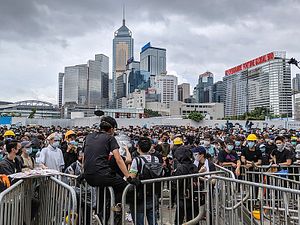Last year, news sites around the world were monopolized by images of Hong Kong’s central business district, crowded with millions of people asking for democratic reforms. That was before COVID-19 hit and Beijing introduced the freedom-destroying National Security Law. But despite the crash of democratic dreams in the former British colony, the wind of contention blowing from Hong Kong is helping thousands of others to breathe. From Thailand to Belarus, protesters are perfecting Hong Kong’s blueprint for resisting state authority.
Social dissent these days has a new catchphrase: “be water.” Inspired by a quote from martial arts icon Bruce Lee, the phrase was repurposed by Hong Kong’s pro-democracy movement during their campaign against the 2019 extradition bill. The concept calls for movements to take on an amorphous, leaderless and fast-flowing approach. Thanks to live-streaming on social media, demonstrators share vital information – such as the whereabouts of police – to avoid a crackdown. The strategy was tested in Hong Kong and soon implemented halfway across the world by Catalan demonstrators, determined to defend the region’s freedoms from the central Spanish government. The Catalans, who had named themselves “Tsunami Democrátic,” set off for Barcelona El Prat international airport in October 2019, chanting, “We’re going to pull a Hong Kong!”
More recently, the strategy has been reproduced in Minsk, where protesters are calling for President Alexander Lukashenko’s resignation. It is not the first time: people had complained about Belarus’ Vladimir Putin-backed ruler both in 2011 and 2017. But, for the very first time, the government is struggling to repress dissent. The reason? Demonstrators, inspired by Hong Kong’s activists, play cat-and-mouse with the police; they use Telegram channels to avoid crackdowns and purposefully have no defined leaders.
The journey of the Hong Kong protest playbook to Europe is remarkable, but it is also producing results closer to home. Thai demonstrators have been protesting against the government of Prime Minister Prayut Chan-o-cha since the summer. They are demanding Prayut’s resignation and reforms to rein in the power of the Thai monarchy. Thai protesters have also started “being water”: they use Telegram channels to organize actions and, following the imprisonment of key protest leaders, they have been avoiding delegations of power. “Get your megaphones ready, your protective gear on, because everybody is a leader,” posted the Thai group Free Youth on its social media accounts.
Protests in Thailand are quickly earning foreign support. The #MilkTeaAlliance, an online movement of solidarity bringing together Hong Kongers, Taiwanese and Thais, may soon become the new flagship of anti-authoritarianism in broader Southeast Asia. The hashtag is now moving into the physical space of protests, with Thai protesters chanting, “Hong Kong is a country, return independence to them.” Hong Kongers and Thais have also joined forces during pro-democracy rallies in London.
“Shapeless” and “leaderless” are quickly becoming the new keywords for social movements. And it looks like there cannot be one without the other. Not only is lack of leadership essential to fluidity (protesters cannot just assemble and split if they are following someone’s directives), but it also allows movements to avoid government crackdowns. As Hong Kong-based journalist Anthony Dapiran has observed, “With no obvious leader, there’s no one to imprison.” Even Black Lives Matter, despite the heritage of civil rights leaders as charismatic as Dr. Martin Luther King, Jr. and Malcolm X, is now taking a leaderless approach to social action.
How are formless, leaderless movements keeping organized? Technology is the one thing common to all contemporary social movements, regardless of their grievances and demands. In the words of Carne Ross, author of “The Leaderless Revolution: How Ordinary People Will Take Power and Change Politics in the 21st Century,” “Technology means you don’t need a leader to disseminate strategy, the strategy disseminates horizontally.”
As time passes and new protests flare up across the globe, all this may start to seem obvious. But the reality is, we owe it to the Hong Kongers.
Silvia Frosina is an Italian journalist focusing on Chinese and East Asian politics. Her work appears regularly on Il manifesto and China Files, a Beijing-based editorial agency.

































